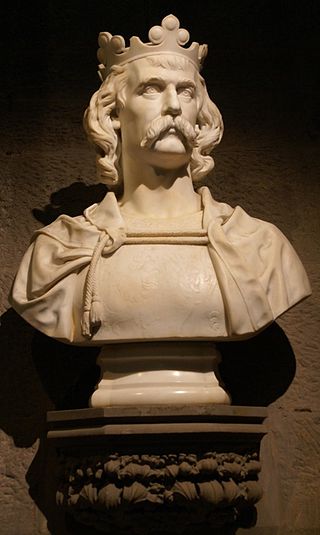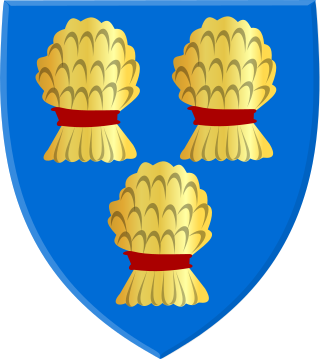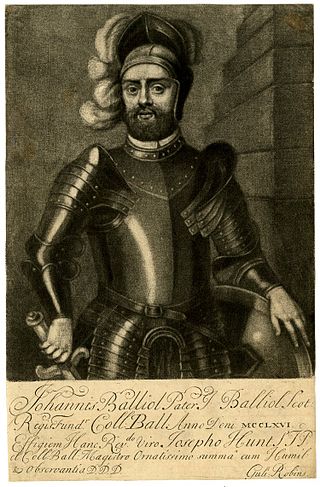Sources
- Creighton, Mandell (1887). . In Stephen, Leslie (ed.). Dictionary of National Biography . Vol. 11. London: Smith, Elder & Co. p. 440.
- Stenton, Frank M. Anglo-Saxon England. 3rd ed. Oxford University Press: Oxford, 1971.
Robert de Comines | |
|---|---|
| Died | 28 January 1069 Durham, County Durham, England |
| Cause of death | Burnt to death |
| Title | Earl of Northumbria |
| Term | 1068–1069 |
Robert de Comines (died 28 January 1069) (also Robert de Comines, Robert de Comyn) was briefly Earl of Northumbria.
His name suggests that he originally came from Comines, then in the County of Flanders, and entered the following of William the Conqueror.
He was sent to the north as earl from 1068 to 1069 after the deposition of Gospatric. He reached Durham with 700 men, where the bishop, Æthelwine, warned him that an army was mobilised against him. He ignored the warning and, on 28 January 1069, the rebels converged on Durham and killed many of his men in the streets, eventually setting fire to the bishop's house where Robert was staying. He was consumed by the blaze. [1]
After this attack, Æthelwine turned against the Normans and gathered an army in Durham before marching on York, leading to the Harrying of the North in retaliation by King William's army.
Robert de Comines could be the father of: [2]
{{cite book}}: CS1 maint: date format (link)
Robert I, popularly known as Robert the Bruce, was King of Scots from 1306 to his death in 1329. Robert led Scotland during the First War of Scottish Independence against England. He fought successfully during his reign to restore Scotland to an independent kingdom and is regarded in Scotland as a national hero.

Year 1069 (MLXIX) was a common year starting on Thursday of the Julian calendar.

The wars of Scottish Independence were a series of military campaigns fought between the Kingdom of Scotland and the Kingdom of England in the late 13th and early 14th centuries.
Waltheof, Earl of Northumbria was the last of the Anglo-Saxon earls and the only English aristocrat to be executed during the reign of William I.
Andrew Moray, also known as Andrew de Moray, Andrew of Moray, or Andrew Murray, was an esquire, became one of Scotland's war-leaders during the First Scottish War of Independence. Moray initially raised a small band of supporters at Avoch Castle in early summer 1297 to fight King Edward I of England. He soon had successfully regained control of the north for the absent Scots king, John Balliol. Moray subsequently merged his army with that of William Wallace, and jointly led the combined army to victory at the Battle of Stirling Bridge on 11 September 1297. In the fighting at Stirling, Moray was severely wounded. He died at an unknown date and place that year.

John Comyn III of Badenoch, nicknamed the Red, was a leading Scottish baron and magnate who played an important role in the First War of Scottish Independence. He served as Guardian of Scotland after the forced abdication of his uncle, King John Balliol, in 1296, and for a time commanded the defence of Scotland against English attacks. Comyn was stabbed to death by Robert the Bruce before the altar at the church of the Greyfriars at Dumfries, once it had been declared that Comyn had more connection to King David of Scotland and therefore should be the next King of Scotland, not Robert.

John de Balliol was an English nobleman, belonging to the House of Balliol. Balliol College, in Oxford, is named after him.

Antony Bek was a bishop of Durham and the Patriarch of Jerusalem.

The Harrying of the North was a series of military campaigns waged by William the Conqueror in the winter of 1069–1070 to subjugate Northern England, where the presence of the last Wessex claimant, Edgar Ætheling, had encouraged Anglo-Saxon Northumbrian, Anglo-Scandinavian and Danish rebellions. William paid the Danes to go home, but the remaining rebels refused to meet him in battle, and he decided to starve them out by laying waste to the Northern shires using scorched earth tactics, especially in the historic county of Yorkshire and the city of York, before relieving the English aristocracy of their positions, and installing Norman aristocrats throughout the region.

John Comyn II of Badenoch, nicknamed the Black Comyn, was a Scottish nobleman, a Guardian of Scotland, and one of the six Regents for Margaret, Maid of Norway. His father was John Comyn I of Badenoch.

The diocese of Durham is a diocese of the Church of England in North East England. The boundaries of the diocese are the historic boundaries of County Durham, meaning it includes the part of Tyne and Wear south of the River Tyne and contemporary County Durham north of the River Tees. It contains 249 parishes and 292 churches. Durham Cathedral is the seat of the bishop of Durham, and the diocesan offices are located just outside the city at Stonebridge. The bishop lives in Bishop Auckland and has offices in Auckland Castle.
Uhtred of Bamburgh, was ruler of Bamburgh and from 1006 to 1016 the ealdorman of Northumbria. He was the son of Waltheof I, ruler of Bamburgh (Bebbanburg), whose family the Eadwulfings had ruled the surrounding region for over a century. Uhtred's death by assassination was described in De obsessione Dunelmi and has been interpreted as the beginning of a blood feud. Not to be confused with Uhtred the son of Eadwulf I of Bamburgh, which is why he historically has been referred to as Uhtred the Bold.
Æthelwine was the last Anglo-Saxon bishop of Durham, the last who was not also a secular ruler, and the only English bishop at the time of the Norman Conquest who did not remain loyal to King William the Conqueror.

John Comyn, 3rd Earl of Buchan was a chief opponent of Robert the Bruce in the civil war that paralleled the War of Scottish Independence. He should not be confused with the better known John III Comyn, Lord of Badenoch, who was his cousin, and who was killed by Bruce in Dumfries in March 1306. Confusion between the two men has affected the study of this period of history.
John Comyn (Cumyn) was Lord of Badenoch in Scotland. He was Justiciar of Galloway in 1258. He held lands in Nithsdale and Tynedale.
Lewis de Beaumont was Bishop of Durham during the last half of the First War of Scottish Independence.
William Cumin was a bishop of Durham, and Justiciar of Scotland.
Events from the 1060s in England.
Siward Barn was an 11th-century English thegn and landowner-warrior. He appears in the extant sources in the period following the Norman Conquest of England, joining the northern resistance to William the Conqueror by the end of the 1060s. Siward's resistance continued until his capture on the Isle of Ely alongside Æthelwine, Bishop of Durham, Earl Morcar, and Hereward as cited in the Anglo-Saxon Chronicle. Siward and his confiscated properties in central and northern England were mentioned in Domesday Book, and from this it is clear that he was one of the main antecessors of Henry de Ferrers, father of Robert de Ferrers, the first Earl of Derby.

Clan Cumming, also known as Clan Comyn, is a Scottish clan from the central Highlands that played a major role in the history of 13th-century Scotland and in the Wars of Scottish Independence. The Clan Comyn was once the most powerful family in 13th-century Scotland, until they were defeated in civil war by their rival to the Scottish throne, Robert the Bruce.